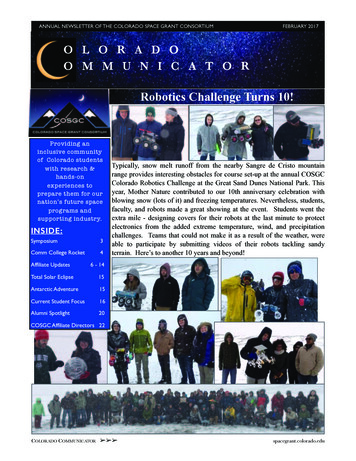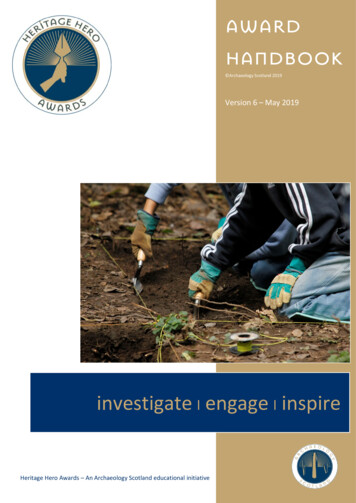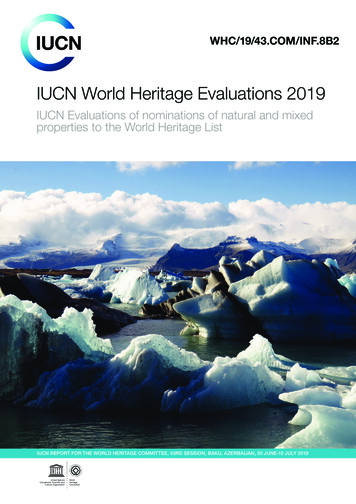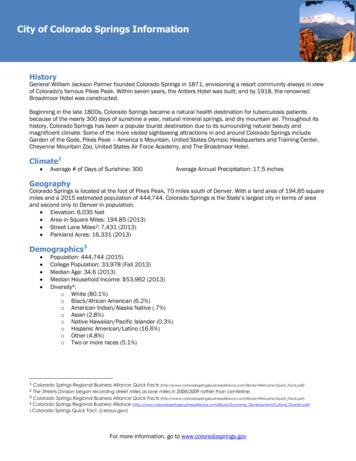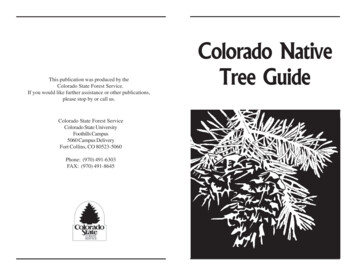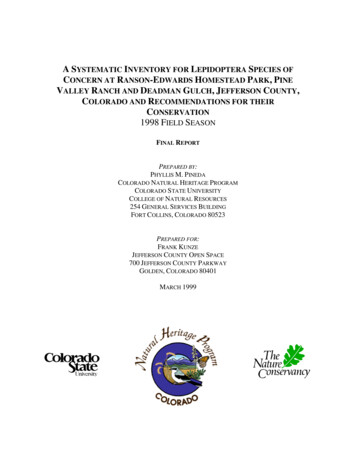
Transcription
A SYSTEMATIC INVENTORY FOR LEPIDOPTERA SPECIES OFCONCERN AT RANSON-EDWARDS HOMESTEAD PARK, PINEVALLEY RANCH AND DEADMAN GULCH, JEFFERSON COUNTY,COLORADO AND RECOMMENDATIONS FOR THEIRCONSERVATION1998 FIELD SEASONFINAL REPORTPREPARED BY:PHYLLIS M. PINEDACOLORADO NATURAL HERITAGE PROGRAMCOLORADO STATE UNIVERSITYCOLLEGE OF NATURAL RESOURCES254 GENERAL SERVICES BUILDINGFORT COLLINS, COLORADO 80523PREPARED FOR:FRANK KUNZEJEFFERSON COUNTY OPEN SPACE700 JEFFERSON COUNTY PARKWAYGOLDEN, COLORADO 80401MARCH 1999
1998 JCOS Lepidoptera InventoryiiTABLE OF CONTENTSTABLES AND FIGURES . IVACKNOWLEDGEMENTS .VEXECUTIVE SUMMARY . 1INTRODUCTION . 2LEPIDOPTERA DIVERSITY OF THE COLORADO FRONT RANGE. 2PURPOSE . 3MAJOR THREATS AND STRESSES TO THE BIODIVERISITY OF THE COLORADO FRONTRANGE . 4RECOMMENDATIONS . 7BACKGROUND .10COLORADO’S NATURAL HERITAGE PROGRAM .10THE NATURAL HERITAGE NETWORK AND BIODIVERSITY .10WHAT IS BIOLOGICAL DIVERSITY? .11THE NATURAL HERITAGE RANKING SYSTEM .12Protection Urgency Ranks .13Management Urgency Ranks .14Element Occurrence Ranks .15Potential Conservation Sites .15Potential Conservation Site Boundaries.16Off-Site Considerations.16Ranking of Conservation Sites .16LEGAL DESIGNATIONS .17METHODS.19RESULTS .20POTENTIAL CONSERVATION SITES .21Potential Conservation Site Format .26ROCKY FLATS .27LOOKOUT MOUNTAIN.32PINE VALLEY .36REFERENCES AND LITERATURE CITED .41APPENDICES .46APPENDIX A. CHARACTERIZATION ABSTRACTS .47Erynnis martialis .48Stinga morrisoni.50Hesperia ottoe.51Hesperia leonardus montana .53Polites rhesus .56Polites origenes rhena .58Atrytone arogos iowa .60Paratrytone snowi .62Euphyes bimacula .64Atrytonopsis hianna turneri .65
1998 JCOS Lepidoptera InventoryiiiCallophrys mossii schryveri .67Celastrina humulus .69Speyeria idalia .71APPENDIX B. LEPIDOPTERA PHENOLOGIES.73APPENDIX C. ASSOCIATED LEPIDOPTERA SPECIES.79APPENDIX D. LEPIDOPTERA SPECIES KNOWN FROM JEFFERSON COUNTY, COLORADO .80
1998 JCOS Lepidoptera InventoryivTABLES AND FIGURESTABLESTABLE 1. DEFINITION OF COLORADO NATURAL HERITAGE RARITY RANKS. .12TABLE 2. FEDERAL AND STATE AGENCY SPECIAL DESIGNATIONS. .17TABLE 3. TARGETED LEPIDOPTERA SPECIES OF CONCERN. .20TABLE 4. TARGETED INVENTORY AREAS AND RELATED TARGETED LEPIDOPTERA SPECIES. .21TABLE 5. POTENTIAL CONSERVATION SITES. .22TABLE 6. NATURAL HERITAGE ELEMENTS AT THE ROCKY FLATS SITE. .29TABLE 7. NATURAL HERITAGE ELEMENTS AT THE LOOKOUT MOUNTAIN SITE.34TABLE 8. NATURAL HERITAGE OCCURRENCES AT THE PINE VALLEY SITE. .37TABLE 9. ADULT PHENOLOGIES FOR TARGETED SPECIES OF CONCERN. .73TABLE 10. RARE AND IMPERILED LEPIDOPTERA SPECIES KNOWN FROM JEFFERSON COUNTY. .80FIGURESFIGURE 1. TARGETED INVENTORY AREAS AT RANSON-EDWARDS HOMESTEAD PARK. .23FIGURE 2. TARGETED INVENTORY AREA AT DEADMAN GULCH. .24FIGURE 3. TARGETED INVENTORY AREAS PINE VALLEY RANCH. .25FIGURE 4. ROCKY FLATS POTENTIAL CONSERVATION SITE (INCLUDES RANSON-EDWARDS HOMESTEADPARK). .31FIGURE 5. LOOKOUT MOUNTAIN POTENTIAL CONSERVATION SITE (INCLUDES DEADMAN GULCH). .35FIGURE 6. PINE VALLEY POTENTIAL CONSERVATION SITE (INCLUDES PINE VALLEY RANCH). .39
1998 JCOS Lepidoptera InventoryvACKNOWLEDGEMENTSThis project would not have been possible without the interest and concern ofJefferson County Open Space department for the butterflies, skippers and moths of theColorado Front Range. The Colorado Front Range is always a particularly exciting andinteresting area for Lepidoptera surveys, as the diversity of these beautiful creatures isamazing. Keeping this in mind, we would like to acknowledge Frank Kunze of JeffersonCounty Open Space for giving us the opportunity and support to conduct these surveys.Recognition is also very much in order for Boris Kondratieff, Paul Opler, RayStanford and Andrew Warren for consultation, positive identification, and photographs,and who have optimistically encouraged further reflection into the significance ofinvertebrates in the big picture. Also to Michael Wunder who has been of tremendoussupport to me as I make my transition into graduate school.Finally, much appreciation to my field assistant, Taé Nosaka, who was ofimmense assistance, and who strengthened my knowledge and appreciation of the circle.
1998 JCOS Lepidoptera Inventory1EXECUTIVE SUMMARYColorado's union of the Rocky Mountains with the Great Plains creates an exceptionallydiverse set of circumstances: moist montane forests, lush tallgrass prairies, arid shortgrassprairies, and desert life zones. This fantastic and unusual array of distinct, but co-occurringecosystems all can be encountered within the boundaries of Jefferson County's Open Spaceareas. This exceptional variety of habitats provides for a remarkably diverse assemblage ofbutterflies, skippers and moths. Representatives from the biogeographic regions of the northernarctic and boreal biomes, Rocky Mountains, southwestern deserts, and grasslands of the GreatPlans may all be encountered here.With this information in mind the Colorado Natural Heritage Program (CNHP) wascontracted by Jefferson County Open Space in 1998 to conduct a systematic inventory of rareand imperiled butterflies, skippers, and moths (Lepidoptera) on selected Open Space properties.The goal of this project was to accumulated and examine existing biological data, incorporateappropriate field surveys, identify significant natural heritage resources (rare or imperiledLepidoptera populations) occurring on Jefferson County Open Space Properties. Theinformation is prioritized according to conditions of the populations and species' level ofimperilment. We were also asked to make recommendations on actions that will protect theseresources.A total of seven Targeted Inventory Areas (TIAs) were selected for this survey in 1998.During the 1998 field season, all TIAs were surveyed. We located Lepidoptera of concern infive of the TIAs surveyed. More than one species of concern was located within two of the TIAssurveyed. Furthermore, we identified three species of moths, which are uncommon or rare in thecollection at Colorado State University.In all, six of the thirteen targeted species of concern were documented within the selected areasof Jefferson County Open Space. At least five of these were of global significance. A colony ofthe hops-feeding azure (Celastrina humulus), a globally rare butterfly found in restricted habitaton the Colorado Front Range, was newly documented for Pine Valley Ranch. Surveys at PineValley Ranch also resulted in a reconfirmation of the Listed Threatened Pawnee montane skipper(Hesperia leonardus montana), a subspecies of skipper that is restricted to the South PlatteCanyon of Colorado. The Ottoe skipper (Hesperia ottoe), also a globally rare species waslocated successfully at Ranson-Edwards Ranch, as was the Arogos skipper (Atrytone arogos).The Regal fritillary (Speyeria idalia) also a globally rare species, and one that has seen adramatic decline in numbers since the 1980s, was documented from these surveys at RansonEdwards Ranch. The remainder of targeted species encountered is of statewide significance.Overall, the concentration of rare Lepidoptera species in these three areas indicate that themanagement approaches of Jefferson County Open Space could have global impacts in theconservation of biological diversity.Based on the combination of information collected in this study and previously existinginformation, three potential conservation sites have been identified for JCOS. The three sites inthis report are designated as globally significant, based on the location of globally significantLepidoptera species. Briefly, these three sites are the Rocky Flats Site (includes the RansonEdwards Homestead Park), Lookout Mountain (includes Deadman Gulch), and Pine Valley(includes Pine Valley Ranch Open Space).
1998 JCOS Lepidoptera Inventory2INTRODUCTIONIn 1998, The Colorado Natural Heritage Program (CNHP) was contracted by JeffersonCounty Open Space (JCOS) to assess the biodiversity values of Deadman Gulch and Pine ValleyOpen Space parks. A separate contract covered a newly acquired portion of open space, theRanson-Edwards Homestead Park near the Rocky Flats area, and is also covered in this report.The goal of the project was to accumulate new biological data and examine existing data fromthe area, incorporate appropriate portions into the CNHP's Biological Conservation Database(BCD), and with appropriate field verification, identify significant natural heritage resources.Natural heritage resources are defined as rare, threatened, endangered, or sensitive species andsignificant natural communities that are monitored by CNHP. In short, we were to identify thosesites supporting unique or exemplary natural communities, rare plants and rare animals, andother significant natural features. It is within the purpose of this effort to identify theconservation sites that will protect these most sensitive elements of natural diversity. We alsosupplied information for potential Lepidoptera habitat within these open space areas.Lepidoptera Diversity of the Colorado Front RangeThe Colorado Front Range and its eastern foothills are well known for their biologicaldiversity (Opler 1994, Whitney 1983, Armstrong 1972). The convergence of the RockyMountains’ interface with the Great Plains provides an unusual variety of environmentalconditions, supporting moist and arid zones, mountain and plain habitats, forest and grasslandcommunities. This provides for a heterogeneous group of organisms representing thebiogeographic elements of northern arctic and boreal biomes, Rocky Mountains, southwesterndeserts, and grasslands of the Great Plains.Lepidoptera species are particularly numerous on the Front Range of Colorado.Approximately 176 of 750 North American (north of Mexico) species of butterflies and skippersare resident or regular colonists on the Colorado Front Range, making it the fourth richestbutterfly region in the United States (Opler 1994, Opler and Krizek 1984). Additionally, thenumber of species of moths thought to occur in Colorado is estimated at about 3,000 (P.A. Oplerpers. comm). At the highest elevations, butterflies and skippers of arctic affinities occur at theirsouthern limits. Species typical of the Rocky Mountain boreal forests are found at middleelevations and reach their eastern limits here. The lowest elevations of the foothills and adjacentplains support Great Plains species at the western limits of their range, and those of thesouthwestern mountains and deserts occur near their northern limits. The highest speciesrichness in butterflies occurs in the low foothills and foothill canyons (Opler 1994), an area richin other taxa as well (Weber 1995, Jones 1987, Armstrong 1972). Generally, species richnessestimates for moths are less well known. However, as more research is accumulated, indicationsfor the species richness levels of moths in Colorado appear remarkable.While the high diversity of species of this area is largely due to the mixing of thesedistinctive flora and faunas, several taxa are endemic to the Front Range foothills and adjacentplains (Opler 1994, Armstrong 1972). Such regional endemics are considered by the CNHP ashigh priorities for conservation efforts, and have importance on an evolutionary scale as well.Among butterflies, the hops-feeding azure (Celastrina humulus) and Schryver’s elfin(Callophrys mossii schryveri) are two such examples.Also of high conservation priority are species of the eastern Great Plains occurring indisjunct populations along the Colorado Front Range. Such species include the Ottoe skipper
1998 JCOS Lepidoptera Inventory3(Hesperia ottoe), the Arogos skipper (Atrytone arogos), the dusted skipper (Atrytonopsishianna), the crossline skipper (Polites origenes), and the two-spotted skipper (Euphyesbimacula). Such disjunct populations are often of conservation significance (Lesica andAllendorf 1995) because genetic diversity and adaptation of the species can be greatly affectedby habitat fragmentation. The results of preserving genetic diversity and intact habitat canprotect species from local catastrophic events. Furthermore, many of these species areassociated with xeric or mesic tallgrass prairies (Andropogon gerardii-Schizachyrium scopariumor Andropogon gerardii-Sorghastrum nutans) that display a similar disjunct distribution and arepotentially threatened by ever increasing land conversion. High rates of habitat destructionthroughout the Great Plains region increases the importance of these disjunct populations. TheOttoe skipper is vulnerable throughout its range (G3G4), as is the Arogos skipper (G3G4), thusincreasing the conservation importance of Colorado populations (see the section on NaturalHeritage Ranking System for global, state, and biodiversity ranking definitions).Other eastern species reaching the western limit of their distribution here are endemic tothe western Great Plains shortgrass habitats. Species of conservation concern due to their localrarity or sensitivity to disturbance include the rhesus skipper (Polites rhesus) (G4S2S3) and theColorado blue (Euphilotes rita coloradensis) (G4T2T3S2).Still, other species of the Front Range are distinctly characteristic of the Southern RockyMountains. While many of these still find ample undisturbed habitat throughout themountainous areas of Colorado, Snow’s skipper (Paratrytone snowi) (G4S3) is of conservationconcern and possible dependency on late-successional forest (Opler pers. comm).Butterfly and skipper species whose ranges are centered in the deserts of southwest NorthAmerica are also found on the Front Range. Of these, the arrowhead skipper (Stinga morrisoni)(G4S3S4) and the hilltop little skipper (Amblyscirtes simius) (G4S3) are of some conservationconcern due to localized distributions and habitat preferences.PurposeThe purpose of this study was to identify areas in special need of Lepidopteramonitoring, as well as to provide baseline information regarding which species are foundin selected Jefferson County Open Space areas. Knowing the locations of rare orimperiled butterfly species is the first step towards effective conservation of the speciesand their habitats.To assist in such efforts, the Colorado Natural Heritage Program conducted asystematic inventory of selected Jefferson County Open Space properties for Lepidopteraspecies of conservation concern. By combining detailed distributional information withavailable information regarding species’ ecological requirements, useful protection andmanagement recommendations have been made. The implementation of theserecommendations would add considerably to the effective conservation of biologicaldiversity on the Colorado Front Range, and have global implications for some species.In addition to the value of protecting uncommon species, the presence and abundance ofLepidoptera species can serve as an indicator of environmental change, and may be severelyaffected by various management activities (Pollard and Yates 1993). Simple non-intrusivemonitoring techniques described by Pollard and Yates (1993) have been widely employed inGreat Britain and are gaining favor in the United States (Opler 1994). Such monitoringrecommendations were to be made, if warranted.
1998 JCOS Lepidoptera Inventory4MAJOR THREATS AND STRESSES TO THE BIODIVERISITY OF THECOLORADO FRONT RANGE1. Alteration of natural ecological processes. Since colonial times, human settlementhas drastically impacted large landscape features, including grasslands and forests along theColorado Front Range. In general, most of the ecosystems along the Front Range of Coloradohave evolved with natural disturbances such as grazing and/or fire. Alteration of these naturaldisturbances can alter ecological functions such as plant succession and nutrient and energycycles that in turn impact other balances in the ecosystem.2. Alteration of natural fire regimes in natural habitats allows certain species toinvade sites where they otherwise would not occur and allows fire fuels to build up tocatastrophic levels. Suppression of fires due to settlement and residential development hasaltered vegetation structure, plant community composition and has resulted in increased fire fuelloads. Fires that are more severe than they were historically could result (Hobbs 1987),especially in areas invaded by cheatgrass (Bromus tectorum) and smooth brome (Bromopsisinermis).Fire return intervals in the southern Rocky Mountains range from estimates of 200-400years for subalpine Pinus contorta (lodgepole pine) and Picea engelmannii-Abies lasiocarpa(Engelmann spruce-subalpine fir) forests to 50-150 years for lower elevation Pinus contortaforests (references summarized by Peet 1988). Insect outbreaks due to increased tree densityhave also had dramatic effects on Rocky Mountain forests, as have human impacts. Increases infire frequency during the late 1800s, fire suppression after settlement, logging, road building,mining, and introduction of non-native species have altered the structure, composition, anddistribution of many of the plant communities. While large stands are common, very few arethought to represent the pre-settlement condition of the forests. Site specific management canrestore natural conditions to some extent but because of the large scale of many ecologicalprocesses in montane forests, natural systems would have to be managed in the context ofmultiple ownerships.3. Alteration of grazing patterns along the Colorado Front Range allows formodifications in plant community composition, often negatively affecting native speciespopulations. The elimination of many native herbivores and replacement with domesticlivestock has altered this natural process. While management with domestic livestock oftenmimics the grazing of native herbivores, certain differences do affect the plant communities(Lauenroth and Milchunas 1991). Certain grazing practices, such as continuous grazing for theentire growing season, can alter the composition of plant communities over time by reducing theabundance of native species and allowing less desirable, non-native species or native increasersto increase in abundance.4. Habitat loss, creation of edge habitats, and fragmentation can be detrimental tomany species of concern known from the Colorado Front Range. In Colorado, housing andurban development, mining, water development, industry, agricultural conversion, and recreationcontinue to negatively impact natural plant communities and their faunal components. Loss ofhabitat occurs either through destructive removal of habitat or through the creation of "edge"habitats or zones.
1998 JCOS Lepidoptera Inventory5Perhaps one of the least easily understood concepts is that of "edge" habitats. “Edge”habitats are zones of sharply contrasting habitats or landscapes (Schwarz et al. 1993). Naturalexamples of these zones may be a grassland and a riparian area, or a grassland and a forest edge.Edges are often created by naturally occurring processes such as floods or fires and will recovernaturally over time. Edges can also be anthropologically created, for example: a grassland andan agricultural field or a grassland and a road. Edges are often dominated by plant speciesadapted to disturbance and have become, as a result, more common and widespread. These areasoften attract high numbers of generalist animal species that are widespread and able to utilizedisturbance tolerant plant species (Rathcke and Jules 1993).These last examples of edge habitat have increasingly become the focus of habitatconservation. As our landscape is increasingly fragmented by large-scale, rapid anthropogenicconversion, these edges become increasingly abundant in the remaining open space areas. As aresult, many generalist species of plants and animals become increasingly common in theseareas, and compete, either directly or indirectly, for food sources with the specialist species(Rathcke and Jules 1993). The specialists, meanwhile, have become increasingly less commonas the overall structure of their habitat landscape is dramatically altered, and interspeciescompetition has increased. Furthermore, the overall reduction of large landscapes jeopardizesthe existence of the specialists further. Specialists that occur in small, patchy populations aremore likely to be excluded from small fragments or be affected by local disturbance events thatcould cause the extinction of the entire population. Specialists that exploit sparse and/orscattered plant species could be threatened by fragmentation (Rathcke and Jules 1993). Should alarge-scale disaster such as fire, flood, or disease occur, populations normally recolonizing afterlandscape recovery may actually be extirpated if they exist in an isolated fragment; they cannottravel the distance to recolonize similar habitat (Moffat and McPhillips 1993).5. Construction of trails and roads negatively impact native plants, animals andplant communities. Increased recreation in open space areas has created a demand for trails andtrail management. It is generally believed that pedestrian and bike trails do not substantiallyfragment the natural landscapes. However, any disturbance to a natural landscape can createfragmentation and edges. Trails, to the native components of a system, may be viewed as breaksor barriers in otherwise natural habitat. Such breaks may impede or eliminate movement byanimals. For example, rodents may avoid trail openings because of exposure to predation(Harker et al. 1993). Habitat specialists are very exacting in environmental requirements and areobligated to conditions of habitat continuity. They often cannot survive for extended periods oftime in small patches and fragments, and cannot exist, as plants occasionally do, in dormantstates during intervals of habitat unsuitability (Oates 1995). Trails are also ideal places for earlysuccessional species to grow because disturbance is continuous and regular. With the arrival ofearly successional vegetation there are edges, and consequently, a preponderance of generalistspecies. It is known that with every edge habitat created, a larger proportion of interior orundisturbed habitat is lost (Schwarz et al. 1993). If the impact of additional formal and socialtrails is considered, the habitat and landscape is increasingly fragmented, resulting in creation ofadditional edge habitat, and increased displacement of natural habitat (Harker et al. 1993).Trails and roads also provide ideal corridors for the spread of non-native and invasiveplants. Many of these species are tolerant of or rely on continuous disturbance from use andmaintenance of the trails to become established. Belcher and Wilson (1989) observed that mostleafy spurge infestations were associated with areas that had been disturbed by human activities
1998 JCOS Lepidoptera Inventory6such as vehicle tracks, road construction, and fire guards. Even in areas that seem relatively freeof non-native species, seeds of non-native species often occur in the seed bank and remain viablefor many years. With trail construction and use, the soil is disturbed, increasing the opportunityfor aggressive non-native species to spread via trail corridors. Trail related erosion alsoincreases the availability of habitat for non-native vegetation. When eroded trails become toodifficult for use, construction of additional trails or going off trail creates additional negativeimpacts on the natural landscape.6. Invasion of non-native species can result in the widespread replacement of nativespecies, often greatly altering ecosystem functions, and is one of the most significant threatsto the natural resources along the Colorado Front Range. European-American settlement ofthe area introduced numerous alien plant species. Some species were intentionally int
A SYSTEMATIC INVENTORY FOR LEPIDOPTERA SPECIES OF CONCERN AT RANSON-EDWARDS HOMESTEAD PARK, PINE VALLEY RANCH AND DEADMAN GULCH, JEFFERSON COUNTY, COLORADO AND RECOMMENDATIONS FOR

